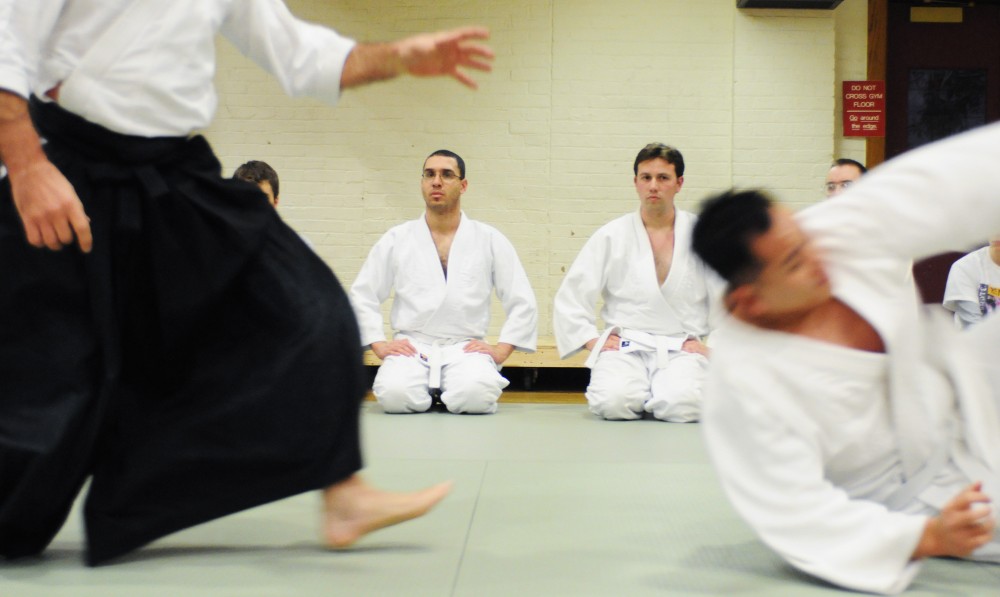Amidst the loud roar of military orders in the large University Armory gymnasium lays a reserved group of aikido members. Perfecting their craft three times a week, aikido is a unique breed of Japanese martial arts that emphasizes control. The UniversityâÄôs Aikido Club Sensei, or instructor, Patrick Riley , has been practicing aikido since 1972 and said itâÄôs different from other martial arts forms. âÄúItâÄôs not about kicking butt,âÄù he said. Directly translated, aikido means âÄúthe way of harmony,âÄù John Rudi , Aikido Club president said. âÄúItâÄôs a philosophy of peace.âÄù About 50 members from surrounding states attended a fall seminar Oct. 11-12 at the Armory, co-sponsored by the University Aikido Club and Aikido of Minnesota. Reverend Zenko Okimura , a Buddhist priest and aikido Shihan lead the seminar and watched seven aikido members attempt to move up in rank. Only with a ShihanâÄôs approval can members receive new belts. Okimura said he wasnâÄôt sure how many other Shihans there were in the United States, but said âÄú10 years ago, there were probably around five.âÄù Okimura, who said he was at Cornell University in New York last week, is only able to come to Minnesota two or three times a year. In aikido, there are no competitions, no winners or losers. Students practice moves at the level of intensity they want with control so as not to hurt their opponent. Erica Redline , who formerly practiced jujutsu, said she turned to aikido when she came to the University for graduate school. âÄú[Aikido] is not used to show off to people,âÄù Redline said. âÄúYou train to do your best not to hurt the [other] person.âÄù Using pressure points, throws and wrist locks, aikido members focus on continuing the flow of an attack. âÄúItâÄôs supposed to be self-defense,âÄù Redline said, âÄúnot a counter offense.âÄù Okimura said aikido is the âÄúsophisticated martial art.âÄù âÄúIf youâÄôre thinking glory, first place type of thinking, aikido is not for you,âÄù Okimura said. âÄúItâÄôs personal development, not short term. [People] come to aikido for the physical but thereâÄôs more to it.âÄù Rudi said while practicing aikido doesnâÄôt have to affect other aspects of life, itâÄôs almost impossible for it not to. âÄúItâÄôs up to the individual,âÄù Rudi said, âÄúbut aikido can be used for redirecting verbal offensive energy, and for making relationships and keeping them.âÄù Okimura said students learn about being focused, and attentive; âÄúSkills and activities you have to do in your daily life.âÄù While aikido is an art that can be embraced by a wide array of people, Okimura, Rudi and Riley all agreed, many Aikido members have a deeper focus. Rudi described many aikido members as esoteric, meaning they arenâÄôt simply seeking out a physical art, but also one of philosophy. The UniversityâÄôs Aikido Club has 12 members on the books Riley said, but members feel closeness to each other not based on group size. âÄúI feel like I could walk into an aikido dojo anywhere and already have a bond,âÄù Riley said. âÄúItâÄôs quality over quantity.âÄù

Image by Marija Majerle
Sensei Patrick Riley, left, and Luan Nguyen practice Aikido at the Armory on Tuesday. Aikido is a unique kind of martial arts that emphasizes control through the use of pressure points, throws and wrist locks.
Aikido Club welcomes special guest
Published October 12, 2008
0

